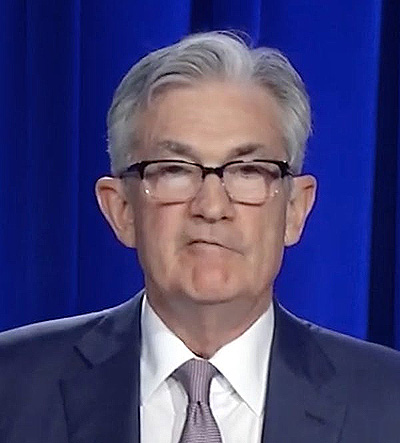Powell Drops a Sledge Hammer on the Market's Dull Head
David Haggith
 Yes, interest rates are going higher for longer because, no, the Fed is not anywhere near done fighting inflation. Yes, interest rates are going higher for longer because, no, the Fed is not anywhere near done fighting inflation.
Fed Chair Jerome Powell made the point clear for stock investors today: the Fed is in the fight to stay … taking interest as high as it takes for as long as it takes, and we aren’t anywhere near there yet. In response, the long brain-dead, zombie stock market tumbled another 250 points on the Dow today, but not until it first did its best to exhibit its zombie brain to denying Powell’s pungently clear statements with an attempted rise. Treasury yields also rose again in response with the 10YR tickling the underside of 5%.
Federal Reserve Chairman Jerome Powell acknowledged recent signs of cooling inflation, but said Thursday that the central bank would be “resolute” in its commitment to its 2% mandate….
“Inflation is still too high, and a few months of good data are only the beginningof what it will take to build confidence that inflation is moving down sustainably toward our goal,” Powell said in prepared remarks. “We cannot yet know how long these lower readings will persist, or where inflation will settle over coming quarters.”
“While the path is likely to be bumpy and take some time, my colleagues and I are united in our commitment to bringing inflation down sustainably to 2 percent,” Powell added….
“Does it feel like policy is too tight right now? I would have to say no,” he said. Still, he noted that “higher interest rates are difficult for everybody.”
Even though the message of higher for longer was starkly stated to where it couldn’t be more clear,
Stocks turned higher after Powell spoke and the 10-year Treasury yield backed off its highs for the session.
However, the misguided attempt at denial quickly reversed.
After a short delay, Powell noted the labor market and economic growth may need to slow to ultimately achieve the Fed’s goal.
“Still, the record suggests that a sustainable return to our 2 percent inflation goal is likely to require a period of below-trend growth and some further softening in labor market conditions,” Powell said.
Even after those clear and reasonable statements, Powell exhibited his own delusions, which are exactly why I’ve said the Fed will tighten us deep into recession.
“We’re very far from the effective lower bound, and the economy is handling it just fine,” Powell said.
Is it? Really. If you listen to those who only go by GDP and jobs, then the economy is strong — resilient — but by many other ways of viewing the economy, it is weak and cracking all over the place. I anticipate laying out those fractures and fails for paid subscribers in my next “Deeper Dive.” But let me tell you: relying so much on the broken labor market is the critical mistake the Fed and many others are making. It is the achilles heal in this whole situation. Normal labor market metrics can’t be depended on when the labor market has been historically damaged in ways that don’t match any time in US history. Labor ain’t what it used to be.
Labor is broke, and no one gets it. Here is how broke it is:
Gross misunderstanding of the broken labor market was exactly the reason I gave about two years ago to explain why the Fed would destroy the economy, and it is the reason the NBER refused to declare a recession last year, when I said we would have one, even though we had two sequential quarters of falling GDP, which normally is a recession. (So, many are now calling it a “technical recession.”)
Says one economist:
Our recession-watch here started shortly after the Fed kicked off its rate hikes in March 2022. The National Bureau of Economic Research (NBER), which calls out recessions, defines them as broad economic downturns that include downturns in the labor market. So, among other things, we’re looking for sharp increases in weekly claims for unemployment insurance benefits, our most immediate measure of the labor market; they’re highly correlated with recessions as defined by the NBER.
That rise in unemployment claims remains elusive but not because demand for labor is so strong. It’s because availability of labor suddenly became so weak. Weakness is not economic strength. We’re suffering an extreme shortage on the labor supply side, not a boom in jobs, and we’ve never had that, so people don’t comprehend it. Jobs look like they are booming in some reports, but dig down through the numbers, and you find the majority of the new jobs have been part-time jobs (but they count the same as full-time jobs), and many new jobs are being recycled as new jobs when they fail to find new employees, so the listing goes off the market only to reappear again later a month or two down the road as another new listing. A lot of it is, in other words, just churn.
Labor supply, while it has recovered to pre-Covid levels, remains well below the trend line it had been on prior to Covid, and that trend matched the long-term trend of population growth. So, we are well below the the number of laborers we would expect from continued population growth. Something went badly wrong. That means we have more consumers but a lower percentage of them who are producers, which contributes to shortages and rising prices.
Make no mistake, though, labor tightness that is due to extreme shortages in labor supply due to the reduction in laborers can power inflation just as much as labor tightness that is due to robust economic growth demanding more laborers, even though they are very different dynamics in the labor market. Lacking competition from their colleagues, laborers are more empowered than ever to strike for higher pay and benefits, and they are certainly getting both.
So, Powell is right in saying the tight labor market will likely drive up inflation, but wrong in thinking it is a sign of a robust economy. It’s just one more sign of a badly damaged economy that many are having a hard time wrapping their heads around.
“Additional evidence of persistently above-trend growth, or that tightness in the labor market is no longer easing, could put further progress on inflation at risk and could warrant further tightening of monetary policy,” he said.
That is exactly why I’ve maintained all along labor would prove to be the Fed’s broken gauge, causing it to tighten and tighten until jobs match down to diminished labor supply and then going further down until the job losses finally start raise unemployment, making for one seriously underperforming economy.
Think of it this way: If you had a small local economy that regularly only employed 100 local workers and then half the workers got chronically ill or died (due perhaps to some strange disease or due to some experimental vaccine that went rogue) while others retired early to where you — in the space of year — suddenly had only 50 local workers, then your economy is clearly weaker, not stronger. Much weaker!
Let’s say employers start cutting jobs back because they just cannot fill them so you get to where the economy only has jobs available for 70 workers (50 filled jobs and 20 openings); you’d still have an extreme labor shortage even with the diminished economy because employers are still trying to get production and services back to where they were, and the workers who remained, being fewer than needed, would be empowered to ask for more money. If they don’t get more money, they will move to the 20 open jobs that cannot find laborers because desperate employers are upping what they advertise in those unfilled jobs to try to scrounge up more workers.
That means, if the Fed stepped into your economy and wanted to get unemployment to rise, it would have to crush out those 20 open jobs. Otherwise, anyone losing one job would just move over to one of the 20, rather than start collecting unemployment benefits that pay only half of what they were making. The local economy would already be down in production because of the labor shortage; so, as the Fed does crush down those 20 surplus jobs that local labor was not able to fill by making things harder economically, it would be hurting an already badly wounded economy even more.
Clearly an economy that is fully employed at 50 people (because that is now all there is) is not producing as much as one that had 100 working people just a short time back (assuming labor efficiency did not change much, just as it hasn’t in the real world outside of our example). Crushing that beleaguered economy down even harder in order to get unemployment to rise among such a reduced labor pool would require taking the local economy down to only 40 employed people in order to get 10 unemployed; but that makes the local economy’s underproduction even worse! (And that could, counter-intuitively, actually make inflation worse, too, by making shortages worse!)
That is where we are in a nutshell, which almost no one is correctly understanding. If the Fed crushes down on the economy enough to finally get unemployment to actually rise when labor supply is well below trend and the economy is already wounded, then the economy will be crushed, indeed. (We’ll talk about the many ways in which the US economy is wounded and weakened in that “Deeper Dive” unless something even more important comes along, having dug pretty deep into the Big Bond Bust this week in regular editorials that were almost like those “Deeper Dives” just because this is such a critical juncture for everyone to understand.)
The Fed and the NBER are relying on broken metrics they do not understand because they have never lived in a world where those were the dynamics behind labor tightness. In a normal, pre-Covid world — i.e., before the world went totally insane — labor tightness, given the number of workers never declined, always meant the economy was strong and demanding more labor. It does not mean that now.
Help your friends understand the bizarre times of economic collapse we live in by sharing this edition of The Daily Doom:
Share
Subscribe to The Daily Doom to keep understanding the bizarre times of economic collapse we are living in. Paid subscribers receive weekday headlines that track the collapse and receive the weekly “Deeper Dives” that dig into what is really happening (but free subscriptions without those benefits are available, too):
 Seeing the Great Recession Before it Hit Seeing the Great Recession Before it Hit
My path to writing this blog began as a personal journey. Prior to the start of this so-called “Great Recession,” my ex-wife had a family home that was an inheritance from her mother. I worked as a property manger at the time, and near the end of 2007, I could tell from rumblings in the industry that the U.S. housing market was on the verge of catastrophic collapse. I urged her to press her brothers to sell the family home before prices dropped. The house went on the market and sold right away — and just three months before Bear-Stearns and others crashed, taking the U.S. housing market down for the tumble. Her family sold at the peak of the market.
www.thedailydoom.com
| 

